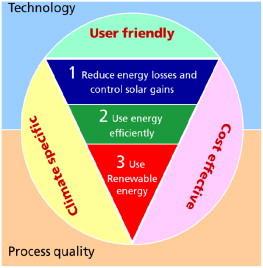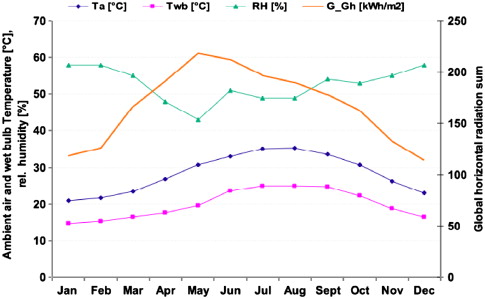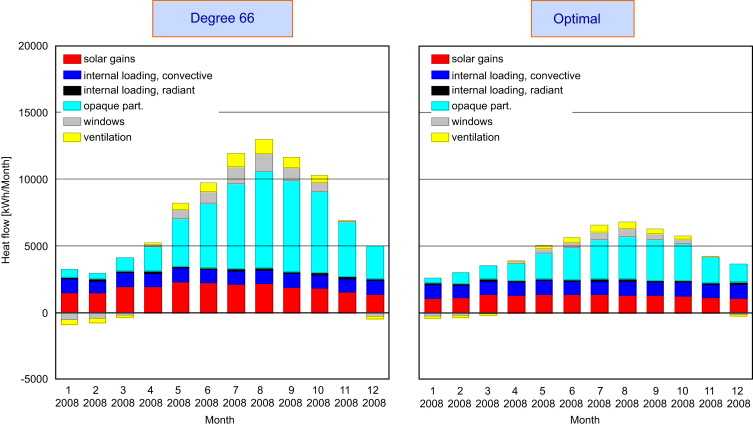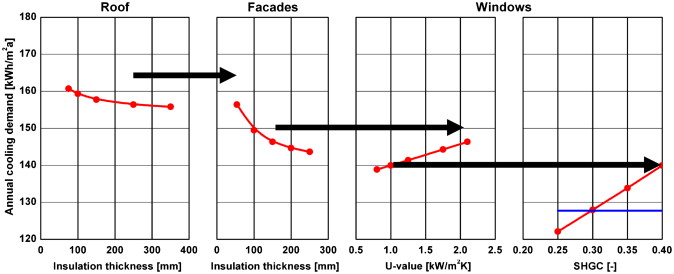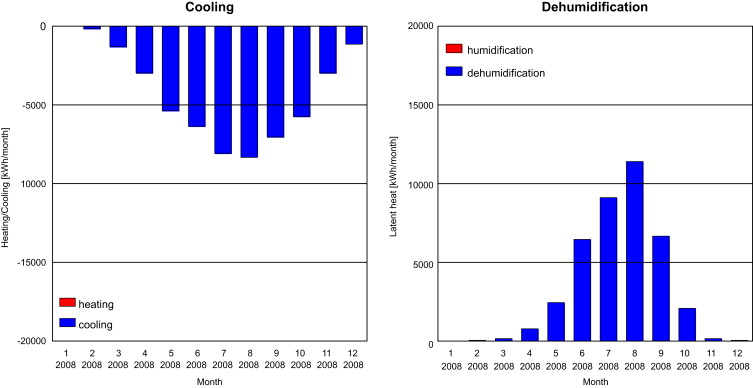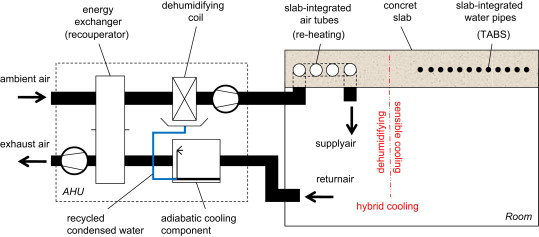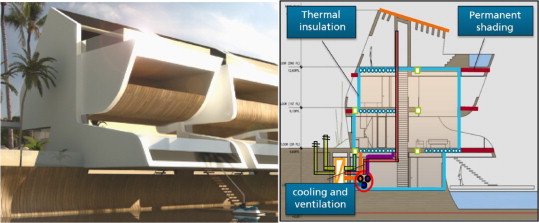Abstract
Designing energy efficient and comfortable buildings requires harmonizing the complex interactions of architecture, construction and building service engineering. The building envelope has a particular importance, since it integrates many functions and has direct influence on indoor climate. Focusing on satisfaction of the user means that the indoor climate is a key for a holistic design approach. Only a satisfied user will not intervene with the designed energy concept or the indoor climate control; dissatisfaction results in multiple system interventions which may cause waste of energy and sometimes even damage to building envelope components. Satisfaction with the indoor environment also increases working productivity or enables effective recreation of residents.
The paper deals with international research activities in the field of climate specific building design. Various comfort and energy monitoring surveys of office buildings as well as residential buildings provide substantial information about the occupants' behavior and their needs during specific situations under different outdoor climates. This information allows summarizing basic climate dependent design principles which architects should keep in mind during the early stages of the design process. It also helps to develop strategies aiming at reducing building energy demand and at the same time consider comfort aspects. The second part of this paper demonstrates application of the climate dependent design principles in a housing project in Dubai.
Keywords
Climate specific design ; Hybrid cooling ; Hygrothermal building simulation ; Energy efficiency
1. Introduction
Climate change and rising energy prices have become worldwide issues in the construction industry and force architects and engineers to come up with improved building design concepts. Furthermore, sustainable planning calls for attention to indoor comfort and damage free construction. Holistic building design is challenging, since climatic boundary conditions have great influence on comfort conditions as well as on the energy efficiency requirements. Focus on creating indoor climate that ensures productive working conditions in office buildings or comfortable conditions in homes is essential. The task of climate specific design is to provide this comfort with a minimum of fossil energy demand while making efficient use of renewable resources.
Architects often ignore climate specific design principles. Native architecture is disregarded and western architecture is transferred to different climate zones without adjustments. Additionally, the lack of standards in some countries leads to an indiscriminate transfer of foreign standards. This results in buildings which do not provide adequate comfort. The only way to compensate this deficiency is to use mechanical equipment with high energy consumption. This paper is to highlight the benefits of climate specific design by reviewing the principles and their practical applications.
2. Climate specific building design principles
The first step is the optimization of the efficiency of the building envelope. This can be achieved by adequate insulation, air-tightness and optimized glazing, which allows the passive use of solar gains in cold climates or limiting solar impact in hot climates. The second step is the selection of an efficient HVAC system (which may be based on renewable energy sources), but the primary focus is on an efficient operation of the system. A principal rule is shown in Figure 1 , where the three steps necessary for an energy efficient building design are depicted. The top priority is reduction of energy losses in cold regions or control of energy gains in hot regions. Only if the building itself is energy efficient advanced technologies using renewable energy sources work efficiently as well.
|
|
|
Figure 1. Principal rules for developing a user friendly and climate specific energy control. |
A good energy control fulfills additional requirements. It has to be climate specific, cost effective and user friendly. There is no ‘best’ technology. The choice of measures depends on climate conditions, micro-climate and available environmental energy, but also on saving potentials and cost-efficiency. The consideration of users behavior and the user acceptance is essential, since the users have to understand and accept the energy saving measures; otherwise the users interact in a way which is probably not supporting the designed energy control. Whether the targeted savings potentials can be achieved in practice depends not only on the used technology but also on degree to which the design process is integrated and on the quality of craftsmanship.
To succeed in designing an optimized building requires understanding of climate specific design principles. This means the overall concept of the construction has to respond to the local environment as well as to the intended use of the building. The main construction features for energy efficient residential or office buildings depend on the outdoor climate and can be summarized as follows:
Cold climate : Compact building design with very well-insulated building envelope components; total fenestration area should be limited with very low U-value and high SHGC (solar heat gain coefficient); mechanical ventilation with heat recovery is essential.
Moderate climate : Well-insulated building envelope with energy efficient fenestration (very low to low U-value, moderate to high SHGC—depends on glazing area); operable shading systems required to prevent summer overheating; thermal mass and mechanical ventilation with heat recovery is beneficial.
Hot and dry climate : Well-insulated building envelope with limited fenestration area; glazing with very low SHGC and shading from direct sunlight in summer; reflective exterior envelope surfaces essential; solar powered AC equipment can provide day-time cooling; thermal mass and lower night-time temperatures provide comfortable indoor conditions after sunset.
Warm and humid climate : Moderately insulated building envelope with limited fenestration area having low SHGC and effective shading devices; green (vegetated) roofs and/or reflective exterior envelope surfaces are beneficial; since the removal of latent heat (water vapor) matches the energy required for sensible cooling, investing in sophisticated ventilation and AC systems is essential to provide healthy and comfortable indoor air conditions without wasting energy.
These basic climate depending design principles should be kept in mind during the early stages of the design process. Once the construction concept is completed, the specifications of the individual construction components and details as well as the definition of the HVAC equipment have to be completed. This should be done by applying whole building simulation tools (e.g., Energy Plus; UIUC, 2007 ) rather than referring to standard code requirements and simple load calculations. If humidity-related problems cannot be excluded as for example in warm and humid climates or in high occupation buildings in cold and moderate climates, hygrothermal whole building simulation tools such as WUFI-Plus (Holm et al., 2003 ) should be employed to check the fitness for purpose of the design.
3. Concepts for a set of net-zero energy houses in the Middle East
The following part describes a project (Zirkelbach et al., 2008 ) in Dubai, where the principles of climate depending design were applied to develop and evaluate an energy control for a set of net-zero energy houses. The task of this project was to develop a master plan for in total 32 individual buildings, each of them with a net floor area of more than 300 m⊃2;, located on an island about 8 km off the coast of Dubai. In achieving a comprehensively planned and integrated community with a sense of luxury the project also expects to set new standards in environmental design, getting close to a net-zero energy concept. This means that the building energy demand is balanced over a year by renewable energies for typical Dubai climate conditions. Compared to building regulations in Dubai, climate specific design reduces the solar gains and helps to provide a comfortable indoor climate while also saving a big part of the necessary energy. Climate specific design bases on a detailed analysis of the local climate parameters and a consequent evaluation of the responses of the building to these parameters. A step by step approach to minimize the energy demand allows an easy evaluation and quantification of the single actions and permits a simple cost–benefit ratio.
Dubai is one of the hottest and most humid cities in the world. Its climate is comparable to that of hot and dry climate zones with the exception of the humidity which is also very high. Therefore not only cooling, also dehumidification is a major issue. The concept is based on two parts, the optimization of the building envelope and the development of an innovative efficient building service system with use of renewable energy; both are optimized with regard to a reduction of building energy demand.
The use of passive means of climate control such as building orientation, shading devices, natural ventilation and operable facades should provide the development with a very strong environmental meaning. Significant impact factors for the energy demand of a building are air temperature, relative humidity and intensity of radiation. A further matter of importance may be wind and precipitation, if it is possible to enhance the interior climate by natural ventilation and evaporative cooling. This means that first of all, the in-situ climate conditions and related factors such as exposition, orientation and building operation have to be carefully analyzed. Responding to these boundary conditions, a building and its technical equipment are to be designed that meet the requirements of a zero emission concept for the conditioning of the indoor climate including auxiliary energy demand (electricity for pumps, etc.).
Especially the dry and wet bulb temperature of the exterior climate and the global radiation (see Figure 2 ) are relevant to the dimension of the HVAC systems. In summary, it can be concluded that the temperature level of the outdoor climate does not require any heating during the whole year while air conditioning in summer seems to be inevitable. Concerning the building concepts, attention must be paid to minimize both heat and radiation gains as far as possible.
|
|
|
Figure 2. Monthly averages of air and wet bulb temperature, relative humidity and global radiation on a horizontal surface in Dubai. |
Various construction measures are proposed to minimize the energy demand for cooling. For the first part, thermal building simulations have been preliminarily conducted to analyze the useful energy demand of the buildings for cooling and dehumidification. This is the prevailing building energy demand due to the hot and humid climate conditions at site. It was completed by useful energy demand calculations for hot water and electricity for plugs and appliances. The energy saving potential of the measures was checked and evaluated. The main measures to minimize the cooling load of a building are as follows:
- low surface–volume ratio (favorably large, multi-storey objects);
- building orientation with main façades preferably in north/south direction (no low angle solar input);
- possibly small window area, double- and triple-glazing, avoiding windows facing east or west;
- preferably automatic shading devices as well as low SHGC-values of the windows;
- high level of insulation, especially on the roof;
- light-colored exterior surfaces;
- low air change rates and ventilation system with enthalpy recovery;
- small alleyways and close building arrangements to provide mutual shading and reduce convective heat loss.
The building envelope was initially designed with respect to the local building standard (Degree 66). Afterwards it was improved and optimized in a step by step approach in order to arrive at the described energy demand targets. Figure 3 shows the monthly distribution of the heat fluxes for the design according to the local energy code. The heat fluxes of different types of building components are represented by various colors. This allows to figure out the highest potential for improvement. In this case the solar gain through the windows and the heat transmission though the opaque partitions appear to be most important. The relatively large roof area of the detached houses is responsible for the dominating fraction of opaque partitions. Further potential for reducing heat flow through the building envelope can be seen in improved windows. In order to investigate the most cost effective measures a parametric study was carried out, whose results are depicted in Figure 4 . Different thicknesses of the insulation layers on the wall and on the roof were tested. For the roof an optimum of 150 mm and for the wall an insulation thickness of 100 mm were found. In the same way the U-value and the SHGC of the windows were evaluated. By optimizing the thermal performance of the envelope, the windows and the ventilation system, significant improvement was achieved (Figure 3 ). Due to the hot and humid climate at site, energy is required for air cooling and dehumidification throughout the year. Figure 5 ; Figure 6 show the monthly dehumidification and sensible cooling rates for the optimized building design. In this case the cooling load is comparable to the dehumidification load (the latter depends mainly on the ventilation rate). This indicates that typically split refrigeration systems cannot be used to cool and dehumidify the room air at the same time.
|
|
|
Figure 3. Monthly heat flows for the design according to the local energy code (left) and for the optimal design (right). |
|
|
|
Figure 4. Impact of the different thermal improvements on the annual cooling demand. |
|
|
|
Figure 5. Monthly sensible cooling and latent cooling (dehumidification) rates. |
|
|
|
Figure 6. Scheme of the air handling unit (AHU) and principle of hybrid cooling. Conditioning of the room with two separate systems for cooling (water based system) and for dehumidification (air-based system). |
After optimizing the building envelope, the concept comprised the development of an energy efficient building services system which has to provide the useful energy calculated in step 1. A standard system for residential houses in such climates is the use of local split-units with air-circulation that are typically installed in each room; natural ventilation through openings like windows and gaps defines the air change rate. However, due to the small heat capacity of air – an index for the potential to store and transport cold or heat – high air flow rates would be required to cover the total cooling demand for the building. This potentially leads to draft, high operation energy demands and dissatisfying noise levels from the local compressor and fans; the local units and pipes are visible. Moreover, the required hygienic air change rate cannot be guaranteed by the self-regulating natural ventilation system. According to the problems which arise from a standard system, an efficient and esthetically convincing, ‘lean’ HVAC concept has been developed. Since only a relative small hygienic air flow rate is required for each villa, dehumidification and sensible cooling has been realized by two separate systems. An air-based system is used to dehumidify the air and a water-based system is used for sensible cooling (since water has a higher heat capacity than air).
The net-zero energy houses are equipped with a mechanical ventilation system. Its main task is to ensure a hygienic air change rate and to dehumidify the air. The air handling unit (AHU) contains an enthalpy recovery component. This rotary air-to-air energy exchanger obtains a recovery rate of up to 80%, which significantly reduces the cooling energy demand due to ventilation. An additional component of AHU is the adiabatic cooling at the exhaust side, which further increases its efficiency. This component cools the exhaust air adiabatically by spraying water into it before the exhaust air enters the recuperator (energy exchanger). This component increases the heat recovery efficiency of the recuperator without the need for additional water since condensed water from the dehumidifying coil of the inlet side is recycled and used by the adiabatic cooling component. The ambient air, which had been cooled below its dew point during the dehumidification process, is naturally re-heated by an air-based thermo-activated ceiling (i.e., air tubes within the slab). The air approaches nearly room temperature before it enters the room at the inlets. An energy demanding backup-heater, as it would exist within a conventional HVAC system, is therefore not required.
Sensible cooling of the rooms is realized by a water-based thermo-active building system (TABS). Such a system is based on chilled water flowing through a pipe-work within the ceiling and cools the surrounding concrete. The cool surface subsequently cools the room due to convection and radiation. Due to the large area of the ceiling, the surface temperature can be close to that of the room air (i.e., low energy system) and still sufficient cooling can be obtained. Thus, the chilled water temperature can be on a higher level than it would be required for a typical air-conditioning system. This leads to a higher efficiency of cold production.
The concept is advantageous from the energy and thermal comfort points of view. As a consequence, a ‘lean’ building concept has been realized according to the use of the AHU (with features like heat recovery, dehumidification and natural reheating) and the TAB-system. The concept is also esthetically convincing, since the system is mainly invisible for the occupants: the system components are hidden within the building construction and plant room. In order to supply the AHU and the TABS with chilled water, a water cooling system is required. Various technologies have been discussed in terms of their feasibility on site. The final concept makes use of solar-assisted vapor compression chillers.
A parametrical study for different operation strategies has been carried out with regard to the energy performance efficiency: the high thermal mass of the thermally activated ceiling concrete is similar to that of a huge heat sink (i.e., cold storage). The room heat gains can be stored during the day and released at night by night-time operation of the TABS. Since the ambient air temperature is lower at night than during day-time, the chillers can release the heat and therefore produce cold water more effectively during night-time operation. The high chilled water supply temperature level (e.g., 15 °C) ensures a good chiller performance (SPI>4). In conclusion, a night-time operation of the chiller is considered to supply the TABS. In contrast, the AHU does not contain any thermal mass and therefore requires a huge cold water storage or 24 h operation. To provide chilled water for dehumidification, its temperature must be below the dew point of the air (e.g., 6 °C) which reduces the chiller performance (SPI≈3.7). A 24 h chiller operation mode with supply temperature at 6 °C is thought to be more economical than night-time operation.
Basically two design strategies are possible for the building services system: de-central and central systems. In the case of a de-central system, the components are implemented locally in each house, while for a central concept the main components for cold and hot water production and air conditioning are provided in a central plant room. In the latter case cold water, hot water and conditioned air are distributed to the houses by a pipe and duct system. Finally, a semi-centralized concept has been considered: cold water is provided by a central system, but hygienic components such as the AHU are installed de-centrally within each house.
The architects realized an appealing building design while taking into consideration the findings of the climate specific development and evaluation of an energy efficient building energy concept. The section drawing of the planned house, depicted in Figure 7 , shows the layer of insulation, which encloses the core volume of the house with air-conditioning. The deep balconies provide permanent shading to the south facing windows. This allows also that large window areas may be oriented toward east or west, in case the master plan of the island demands for it. The advanced cooling and ventilation concept provides best comfort and is invisible for the occupants.
|
|
|
Figure 7. Design of the villas and the main energy saving measures (Puertas, 2008 ). |
4. Conclusion
A holistic building climate design considers the specific outdoor condition of the climate zone as well as the cultural peculiarities which lead to formulating specific requirements. A sustainable energy control requires focusing on the users, the climate and the cost-effectiveness. A combined comfort and energy demand monitoring is of value, to gain profound understanding of the reaction of a building to the specific climate as well as of users’ behavior or user acceptance. It has been demonstrated how houses in an extreme climate can be designed efficiently and how cooling and air-conditioning can be optimized considering the hot temperatures and high humidity.
References
- Holm et al., 2003 Holm, A.H., Künzel, H.M., Sedlbauer, K., 2003. In: Proceedings of the hygrothermal behavior of rooms: combining thermal building simulation and hygrothermal envelope calculation. Eighth International IBPSA Conference, Eindhoven, The Netherlands, 11–14 August 2003, pp. 499–505.
- Puertas, 2008 Puertas, P., A-cero, 2008. The Heart of Europe on The World. 〈www.a-cero.com 〉.
- UIUC, 2007 UIUC, LBNL. 2007. EnergyPlus Input Output Reference, US Department of Energy.
- Zirkelbach et al., 2008 Zirkelbach, D., et al., 2008. Feasibility study for energy efficiency and building physics of the urban development project “The Heart of Europe” in Dubai. IBP-Report, IBP-HTB-15/2008.
Document information
Published on 12/05/17
Submitted on 12/05/17
Licence: Other
Share this document
Keywords
claim authorship
Are you one of the authors of this document?
